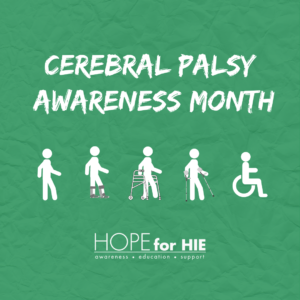
Cerebral palsy is one of the more common diagnoses from HIE. While HIE-related cerebral palsy only accounts for roughly 10-15% of all cerebral palsy causes, roughly 40% of children diagnosed with HIE will be diagnosed with cerebral palsy.
We are sharing all about the connection between HIE and cerebral palsy during March, and sharing resources for our community to learn more.
Fast Facts about HIE and Cerebral Palsy:
Types of Cerebral Palsy:







Diagnosis and Assessment:
Diagnosis for cerebral palsy should be made as soon as suspected. For a long time, many physicians were hesitant to diagnose before the age of two, but as we know, early intervention therapies are very important for the overall development of children with neurological conditions. Many physicians and researchers, including Dr. Bhooma Aravamuthan who serves on our Medical Advisory Board, are leading change and opening discussions to this issue.
Criteria typically includes some imaging, such as an MRI, a medical history, and clinical presentation assessment of how a child moves, and what their muscles are doing, if they have spasticity, dystonia or hypotonia.
As a child develops, many physicians and therapists will assess a child according to the Gross Motor Function Classification System
This system, developed by CanChild, has corresponding benchmarks as children age that may be helpful to look at for parents as well to get an idea of where their child is in their development. Children often can and do move up classifications as they develop and work through therapies.





Be sure to follow us over on Facebook, Instagram, Twitter and LinkedIn throughout the month!
Connect with families, read inspiring stories, and get helpful resources delivered right to your inbox.